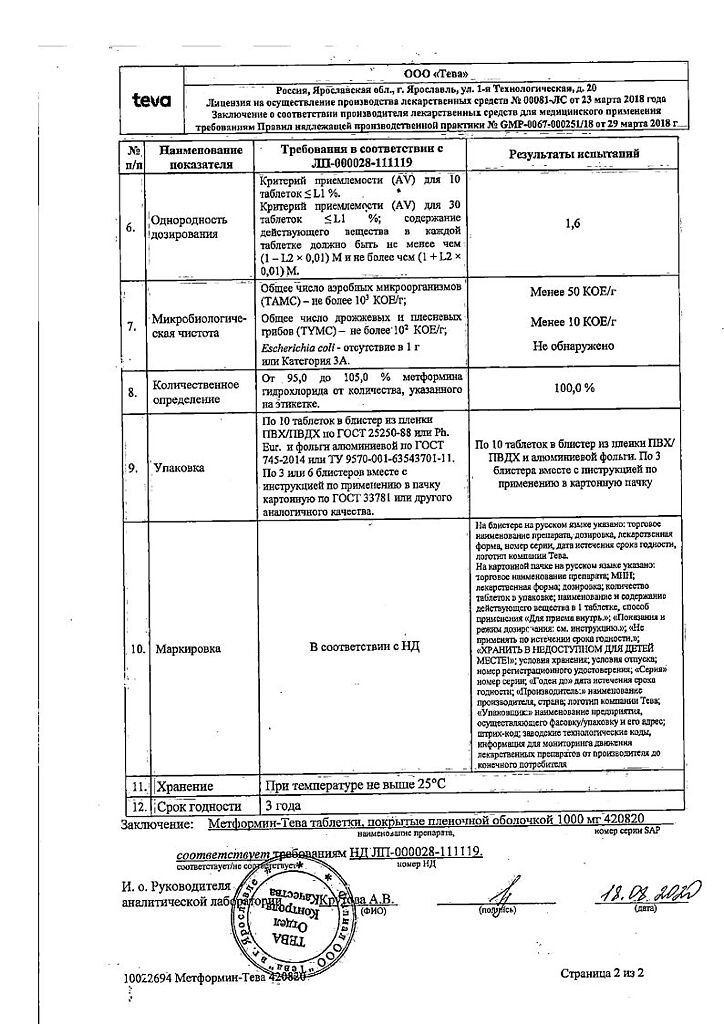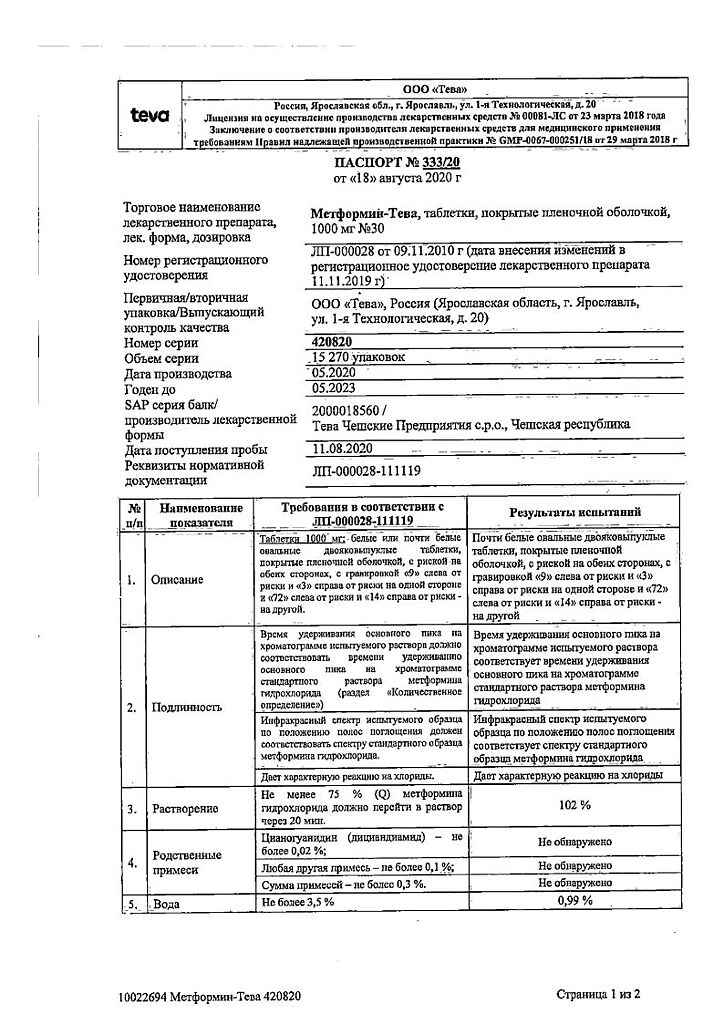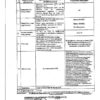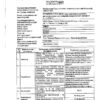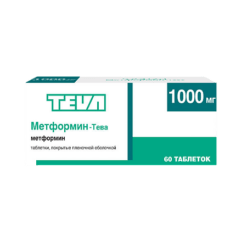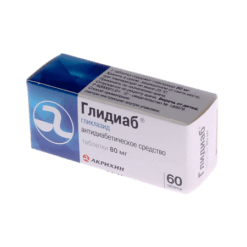No products in the cart.
Metformin-Teva, 1000 mg 30 pcs
€1.00
Out of stock
(E-mail when Stock is available)
Description
Type 2 diabetes without predisposition to ketoacidosis (especially in obese patients) when diet therapy is ineffective; in combination with insulin – in type 2 diabetes, especially with a pronounced degree of obesity, accompanied by secondary insulin resistance.
Active ingredient
Active ingredient
Composition
Composition
Dosage form:
film-coated tablets
Composition:
1 film-coated tablet contains:
the active ingredient
metformin hydrochloride 500.0/850.0/1000.0 mg,
auxiliary substances:
povidone K-30 13.8/23.5/31.6 mg;
povidone K-90 13.3/22.6/22.6 mg,
silicon dioxide colloid 1.2/2.02.4 mg;
Magnesium stearate 2.7/4.6/5.4 mg;
coating Opadray White Y-1-7000H (hypromellose E464 10.0/16.9/20.0 mg; titanium dioxide E171 5.0/8.4/10.0 mg; macrogol-400 1.0/1.7/2.0 mg).
How to take, the dosage
How to take, the dosage
Overly, but during or immediately after a meal.
Monotherapy and combined therapy with other oral hypoglycemic agents
Initial dose: 500-1000 mg once daily in the evening. In 7-15 days with absence of adverse effects of gastrointestinal tract it is prescribed 500-1000 mg 2 times a day in the morning and in the evening. Further gradual dose increase depending on blood glucose concentration is possible.
The maintenance dose: 1500-2000 mg/day. To reduce gastrointestinal side effects, the dose should be divided into 2-3 doses. Maximum dose: 3000 mg/day in 3 doses. Slowly increasing the dose may improve gastrointestinal tolerance of the drug.
Patients taking metformin at doses of 2000-3000 mg/day may be switched to a dose of 1000 mg. The maximum recommended dose is 3000 mg/day in 3 doses. When switching to therapy from another hypoglycemic drug, the other drug should be discontinued and Metformin-Teva should be started at the dose indicated above.
Combinations with insulin
Metformin-Teva and insulin can be used as combination therapy to achieve better glycemic control.
The drug Metformin-Teva is prescribed in the usual starting dose of 500 mg or 850 mg 2-3 times a day. The dose of insulin is adjusted on the basis of blood glucose measurements. After 10-15 days, the dose is adjusted depending on the blood glucose concentration. Maximum dose of metformin in combination therapy: 2 g / day in 2-3 doses. In elderly patients, the daily dose should not exceed 1000 mg/day.
Special Instructions
Special Instructions
Key kidney function should be monitored during treatment. Plasma lactate should be determined at least twice a year, as well as in case of myalgia. In addition, serum creatinine level should be controlled once every 6 months (especially in elderly patients). Metformin should not be prescribed if blood creatinine level is higher than 135 μmol/l in men and 110 μmol/l in women.
Metformin may be used in combination with sulfonylurea derivatives. In this case it is necessary to control blood glucose levels particularly carefully. Metformin should be discontinued 48 hours before and 48 hours after X-ray contrast (urography, intravenous angiography).
In case a patient has a bronchopulmonary infection or urinary tract infection, the attending physician should be informed immediately. During treatment you should refrain from taking alcohol and medications containing ethanol. If alcohol is taken at the same time, lactate acidosis may develop.
Contraindications
Contraindications
Diabetic ketoacidosis, diabetic precoma, coma; renal dysfunction; acute diseases with risk of developing renal dysfunction: dehydration (in diarrhea, vomiting), fever, severe infectious diseases, states of hypoxia (shock, sepsis, renal infections, bronchopulmonary diseases); clinically pronounced manifestations of acute and chronic diseases that may lead to the development of tissue hypoxia (heart or respiratory failure, acute myocardial infarction) serious surgical operations and injuries (when insulin therapy is indicated); liver dysfunction; chronic alcoholism, acute alcohol poisoning; use for at least 2 days before and within 2 days after radioisotopic or radiological studies with the introduction of iodine-containing contrast agent; lactic acidosis (incl.including in anamnesis); keeping hypocaloric diet (less than 1000 calories per day); pregnancy; lactation; hypersensitivity to the drug.
Side effects
Side effects
Nausea, vomiting; metallic taste in the mouth; lack of appetite; diarrhea; flatulence; abdominal pain; lactacidosis (requires discontinuation of treatment; hypovitaminosis B12 (malabsorption); megaloblastic anemia; hypoglycemia; skin rash.
Overdose
Overdose
Symptoms
When using metformin at a dose of 85 g no hypoglycemia was observed, but the development of lactoacidosis was noted. Early symptoms of lactoacidosis are nausea, vomiting, diarrhea, decreased body temperature, abdominal pain, muscle pain, and later there may be rapid breathing, dizziness, impaired consciousness and development of coma.
Treatment
If signs of lactoacidosis occur, treatment with the drug should be stopped immediately, the patient should be urgently hospitalized and, having determined the lactate concentration, the diagnosis should be clarified. The most effective measure for lactate and metformin elimination from the body is hemodialysis. Symptomatic treatment is also carried out.
Similarities
Similarities
Additional information
| Manufacturer | Teva Czech Enterprises s.r.o., Czech Republic |
|---|---|
| Medication form | pills |
| Brand | Teva Czech Enterprises s.r.o. |
Other forms…
Related products
Buy Metformin-Teva, 1000 mg 30 pcs with delivery to USA, UK, Europe and over 120 other countries.


